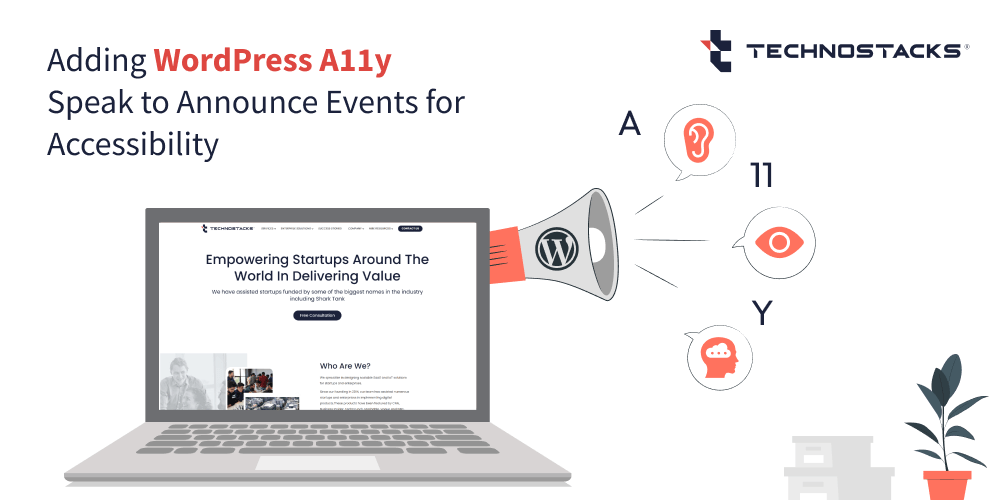Adding WordPress A11y Speak to Announce Events for Accessibility
For many websites, making sure all users, including those with disabilities, can access content equitably is a priority. In WordPress, this means not only ensuring layouts are responsive and content is clear, but also that dynamic content changes are announced to screen reader users, an area known as accessible event notification. This article covers how to use the WordPress A11y speak function to announce events for screen reader users in WordPress.
What Is WordPress A11y Speak?
WordPress A11y Speak is part of WordPress’s accessibility toolkit, specifically developed for notifying screen readers of updates on a page. The wp.a11y.speak function works by injecting text into a hidden element that is automatically read by screen readers. This ensures that any important changes—like form submissions, AJAX updates, or navigation changes—are announced, providing context and feedback for users with visual impairments.
Why Use A11y Speak?
Many standard interactions in WordPress happen dynamically without refreshing the page, such as loading new posts via AJAX or displaying error messages. Without appropriate notifications, screen reader users can be left in the dark, as they won’t automatically know that something on the page has changed. With A11y Speak, you can ensure these dynamic updates are announced, making your WordPress site more accessible.
How to Use wp.a11y.speak in WordPress?
Setting up A11y Speak in WordPress is straightforward. Here’s a step-by-step guide on how to implement it:
Step 1: Enqueue the WordPress A11y Speak Script
To use wp.a11y.speak, you must make sure the necessary accessibility script is loaded. WordPress includes the A11y Speak functionality by default, but it’s good practice to ensure the script is enqueued:
function enqueue_accessibility_scripts() {
wp_enqueue_script( 'wp-a11y' );
}
add_action( 'wp_enqueue_scripts', 'enqueue_accessibility_scripts' );
Step 2: Trigger Speak Notifications
Once you’ve enqueued the script, you can use wp.a11y.speak in your JavaScript files to announce changes.
The speak function accepts two parameters:
1. The message you want to announce.
2. The priority of the announcement—either polite (default) or assertive.
Here’s an example of how you might announce a form submission success message:
// Trigger a screen reader announcement upon form submission
jQuery(document).ready(function($) {
$('#my-form').on('submit', function(e) {
e.preventDefault();
// Your AJAX or form processing code here
// Use wp.a11y.speak to announce the form submission success
wp.a11y.speak( 'Form submitted successfully!', 'assertive' );
});
});
In this example, when a user submits the form, the screen reader announces, “Form submitted successfully!” assertively, interrupting any other ongoing announcements.
Priority Levels: Polite vs. Assertive
The wp.a11y.speak function lets you specify the urgency of the announcement. Choose the priority level that best suits the context:
- Polite: For non-urgent messages, like an image loading or a countdown timer starting.
- Assertive: For urgent messages, like error messages, successful form submissions, or security-related notifications.
// Example of polite announcement wp.a11y.speak( 'Loading new content...', 'polite' ); // Example of assertive announcement wp.a11y.speak( 'Your session has expired. Please log in again.', 'assertive' );
Step 3: Integrate A11y Speak with Dynamic Content
If your WordPress site uses AJAX to load content dynamically, you can use wp.a11y.speak to announce these updates. Here’s how to announce newly loaded posts to screen readers:
jQuery(document).ready(function($) {
$('#load-more-posts').on('click', function() {
$.ajax({
url: '/wp-admin/admin-ajax.php',
data: {
action: 'load_more_posts'
},
success: function(response) {
$('#posts-container').append(response);
// Announce that new posts have been loaded
wp.a11y.speak( 'New posts have been loaded', 'polite' );
}
});
});
});
Step 4: Using A11y Speak in PHP
Sometimes, you may need to call A11y Speak directly from PHP. While JavaScript is the preferred method, here’s how you could pass an announcement from PHP to JavaScript:
function announce_error_message() {
?>
<script type="text/javascript">
wp.a11y.speak( 'An error occurred. Please try again.', 'assertive' );
</script>
<?php
}
add_action( 'wp_footer', 'announce_error_message' );
Best Practices for Accessible Event Notifications
1. Use Clear, Concise Messages: Ensure brief but informative announcements.
2. Limit Usage: Use A11y Speak sparingly to avoid overwhelming screen reader users.
3. Choose Priority Levels Wisely: Reserve assertive for critical information.
Testing Your A11y Speak Implementation
Before going live, test your announcements with a screen reader, such as NVDA (for Windows) or VoiceOver (for macOS). Check that:
- Announcements are read at the right time and with the correct priority.
- Users can navigate away from content if needed without interruption.
- The messages provide meaningful feedback about the user’s actions.
Conclusion
Using WordPress A11y Speak to announce events and dynamic content changes can make your site more accessible, particularly for users relying on screen readers. By implementing this simple but powerful tool, you ensure that all users, regardless of ability, can navigate and interact with your site’s content more effectively. Accessible design benefits everyone, and WordPress makes it easier than ever with tools like wp.a11y.speak.
If you need WordPress-related solutions, our team is here to help! Contact Us.
FAQs
1. What is wp.a11y.speak() in WordPress?
wp.a11y.speak() is a JavaScript method in WordPress that announces dynamic content changes to screen readers using ARIA live regions, enhancing accessibility for users with visual impairments.
2. How do I implement wp.a11y.speak() in my WordPress theme?
To implement wp.a11y.speak(), you need to enqueue the wp-a11y script in your theme and use the wp.a11y.speak() function in your JavaScript code to announce changes.
3. What are the benefits of using wp.a11y.speak() for accessibility?
Using wp.a11y.speak() improves the user experience for screen reader users by providing real-time updates on dynamic content changes, making your website more inclusive and accessible.
4. Can wp.a11y.speak() be used for both polite and assertive announcements?
Yes, wp.a11y.speak() supports both polite and assertive announcements. You can specify the politeness level by passing ‘polite’ or ‘assertive’ as the second parameter in the function.
5. Are there any best practices for using wp.a11y.speak() in WordPress?
Best practices include ensuring the wp-a11y script is loaded after the DOM is ready, using concise and clear messages, and testing with various screen readers to ensure the announcements are effective.








